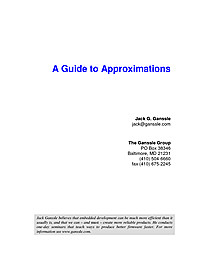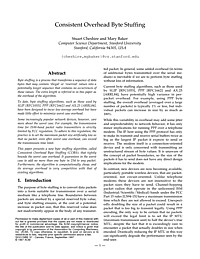A Survey of Techniques For Improving Energy Efficiency in Embedded Computing Systems
Recent technological advances have greatly improved the performance and features of embedded systems. With the number of just mobile devices now reaching nearly equal to the population of earth, embedded systems have truly become ubiquitous. These trends, however, have also made the task of managing their power consumption extremely challenging. In recent years, several techniques have been proposed to address this issue. In this paper, we survey the techniques for managing power consumption of embedded systems. We discuss the need of power management and provide a classification of the techniques on several important parameters to highlight their similarities and differences. This paper is intended to help the researchers and application-developers in gaining insights into the working of power management techniques and designing even more efficient high-performance embedded systems of tomorrow.
Improving performance for dynamic memory allocation
Author provides a good overview of the problems associated with dynamic memory allocation in embedded systems. He then introduces a dynamic memory allocation algorithm and a hash table called "busyhash". The paper concludes with performance comparisons of the standard and the optimized dynamic memory allocation methods.
Memory allocation in C
This article is about dynamic memory allocation in C in the context of embedded programming. It describes the process of dynamically allocating memory with visual aids. The article concludes with a practical data communications switch example which includes a sample code in C.

A Guide to Approximations
Most embedded processors don’t know how to compute trig and other complex functions. Programming in C we’re content to call a library routine that does all of the work for us. Unhappily this optimistic approach often fails in real time systems where size, speed and accuracy are all important issues. The compiler’s runtime package is a one-size-fits-all proposition. It gives a reasonable trade-off of speed and precision. But every embedded system is different, with different requirements. In some cases it makes sense to write our own approximation routines. Why?

Consistent Overhead Byte Stuffing
Byte stuffing is a process that transforms a sequence of data bytes that may contain ‘illegal’ or ‘reserved’ values into a potentially longer sequence that contains no occurrences of those values. The extra length is referred to in this paper as the overhead of the algorithm. To date, byte stuffing algorithms, such as those used by SLIP [RFC1055], PPP [RFC1662] and AX.25 [ARRL84], have been designed to incur low average overhead but have made little effort to minimize worst case overhead. Some increasingly popular network devices, however, care more about the worst case. For example, the transmission time for ISM-band packet radio transmitters is strictly limited by FCC regulation. To adhere to this regulation, the practice is to set the maximum packet size artificially low so that no packet, even after worst case overhead, can exceed the transmission time limit. This paper presents a new byte stuffing algorithm, called Consistent Overhead Byte Stuffing (COBS), that tightly bounds the worst case overhead. It guarantees in the worst case to add no more than one byte in 254 to any packet. Furthermore, the algorithm is computationally cheap, and its average overhead is very competitive with that of existing algorithms.
Memory allocation in C
This article is about dynamic memory allocation in C in the context of embedded programming. It describes the process of dynamically allocating memory with visual aids. The article concludes with a practical data communications switch example which includes a sample code in C.

Consistent Overhead Byte Stuffing
Byte stuffing is a process that transforms a sequence of data bytes that may contain ‘illegal’ or ‘reserved’ values into a potentially longer sequence that contains no occurrences of those values. The extra length is referred to in this paper as the overhead of the algorithm. To date, byte stuffing algorithms, such as those used by SLIP [RFC1055], PPP [RFC1662] and AX.25 [ARRL84], have been designed to incur low average overhead but have made little effort to minimize worst case overhead. Some increasingly popular network devices, however, care more about the worst case. For example, the transmission time for ISM-band packet radio transmitters is strictly limited by FCC regulation. To adhere to this regulation, the practice is to set the maximum packet size artificially low so that no packet, even after worst case overhead, can exceed the transmission time limit. This paper presents a new byte stuffing algorithm, called Consistent Overhead Byte Stuffing (COBS), that tightly bounds the worst case overhead. It guarantees in the worst case to add no more than one byte in 254 to any packet. Furthermore, the algorithm is computationally cheap, and its average overhead is very competitive with that of existing algorithms.

A Guide to Approximations
Most embedded processors don’t know how to compute trig and other complex functions. Programming in C we’re content to call a library routine that does all of the work for us. Unhappily this optimistic approach often fails in real time systems where size, speed and accuracy are all important issues. The compiler’s runtime package is a one-size-fits-all proposition. It gives a reasonable trade-off of speed and precision. But every embedded system is different, with different requirements. In some cases it makes sense to write our own approximation routines. Why?
A Survey of Techniques For Improving Energy Efficiency in Embedded Computing Systems
Recent technological advances have greatly improved the performance and features of embedded systems. With the number of just mobile devices now reaching nearly equal to the population of earth, embedded systems have truly become ubiquitous. These trends, however, have also made the task of managing their power consumption extremely challenging. In recent years, several techniques have been proposed to address this issue. In this paper, we survey the techniques for managing power consumption of embedded systems. We discuss the need of power management and provide a classification of the techniques on several important parameters to highlight their similarities and differences. This paper is intended to help the researchers and application-developers in gaining insights into the working of power management techniques and designing even more efficient high-performance embedded systems of tomorrow.
Improving performance for dynamic memory allocation
Author provides a good overview of the problems associated with dynamic memory allocation in embedded systems. He then introduces a dynamic memory allocation algorithm and a hash table called "busyhash". The paper concludes with performance comparisons of the standard and the optimized dynamic memory allocation methods.



















